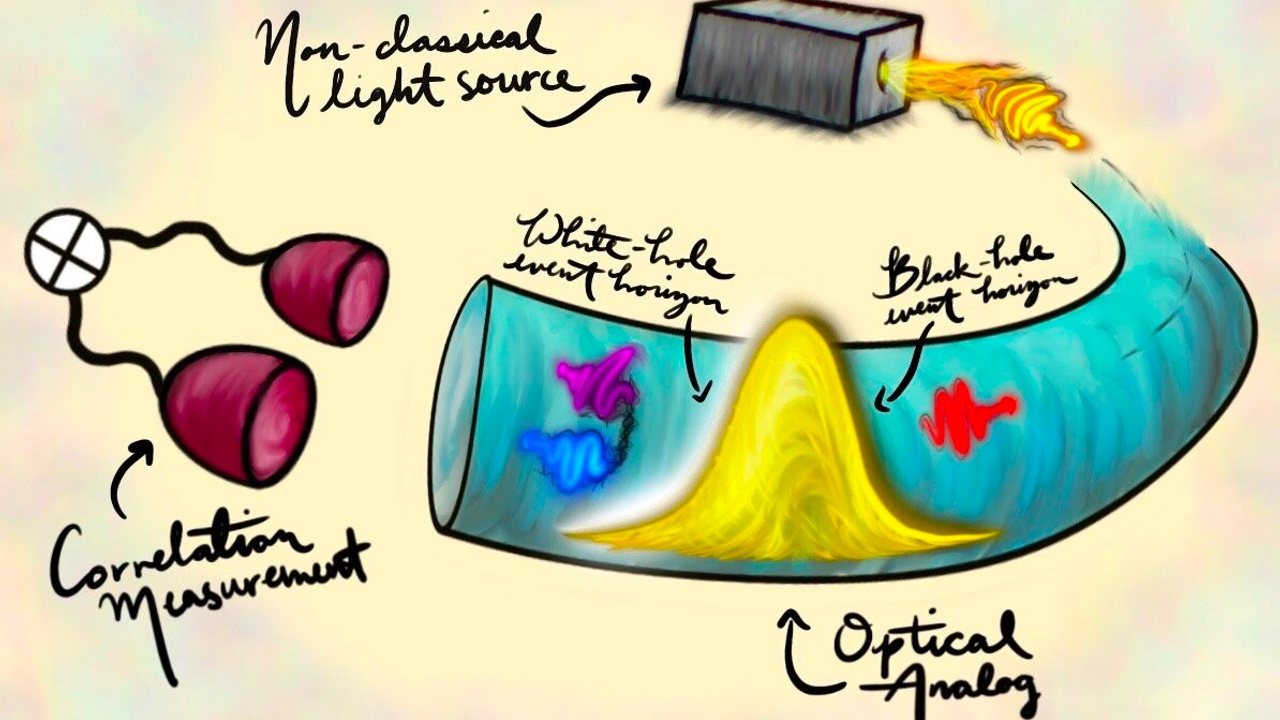Tunable Quantum Entanglement in Stimulated Hawking Radiation in an Analog White-Black Hole Pair

Main image credit: Artist rendering of optical systems containing the analog of a pair white-black hole. 2021 PhD alumnus Anthony Brady, postdoctoral researcher at the University of Arizona
By: William Brown, Biophysicist at the Resonance Science Foundation
Black holes are instrumental in the study of the unification of Quantum Mechanics and General Relativity because they are macroscopic quantum objects—essentially like large particles (which should give a clue that particles are small black holes). In a black hole construct one can study the effects of strong gravity and quantum field theory in a singular system, enabling one to understand both in a singular framework. This also means, however, that one needs a unified theory of quantum gravity to fully understand black holes (and other quantum systems).
The thermodynamics and quantum information (or entropy) of a black hole are of key consideration, especially the relationship between the information comprising the volume within the event horizon of a black hole and the information comprising the surface area of the event horizon. Just such a consideration is what produced the holographic principle within physics [1], [2]. For example, physicist Nassim Haramein has shown that this ratio relationship of surface-to-volume entropy is what produces the observed mass of a black hole—and by extension quantum black holes, that we call particles, like protons.
Theoretical work is invaluable to progressing our understanding of quantum gravity and unified physics, however experimentation is always necessitated to test any theory and to make new discoveries that cannot be discovered by mathematics alone. But how does one study macroscopic black holes in a laboratory? One way is to produce analog black holes, also known as analog gravity systems, that are made of Bose-Einstein condensates, non-linear optical fibers, or even flowing water. Stimulated and spontaneously generated Hawking radiation has recently been observed in several analog systems [3], and now a research team has produced a non-linear optical system that allows one to produce stimulated quantum entangled Hawking radiation [4], potentially allowing for direct experiment and measurement of the quantum entanglement of a black hole surface with the volume within the event horizon.

What is “Hawking radiation” of a black hole? Well, in 1974 Stephen Hawking considered the effect of the strong spacetime curvature of a black hole’s event horizon (the gravitational field) on the quantum vacuum energy fluctuations (of quantum field theory), and found that black holes will emit radiation, like a hot body. Although incomplete, the model suggested that black holes would lose, or “evaporate” their mass away in what is termed the "Hawking evaporation process." Hawking's calculations also showed that the emitted radiation is quantum mechanically entangled with the volume info-entropy of the black hole itself. This entanglement is the quantum signature of the Hawking effect.
Then, in the 1980's, a seminal article by William Unruh demonstrated that the spontaneous production of Hawking quantum entangled particle-pairs occurs in any system that can support an effective event horizon [5]. Because of Einstein’s equivalence principle, that shows acceleration is indistinguishable from a gravitational field, this means that sufficiently accelerating bodies will see spontaneous emission of energy from vacuum—Unruh radiation, or what is more generally called Hawking-Unruh radiation (since the effects are interchangeable under the equivalence principle). Since any system that supports an effective event horizon can be used to study Unruh-Hawking radiation, it opened the door for laboratory tests using analog black hole constructs.
Such laboratory systems not only enable the empirical exploration of principles of unified physics, but they also “bring home” the seemingly outlandish properties of black holes, making them seem a little less bizarre and helping us to see that black hole dynamics are all around us, in flowing water, in propagating sound waves, in cells of the biological system, and many other dynamical systems. A truly remarkable feat will be when we are able to stimulate black hole dynamics to produce gravitational control technologies and generate energy using the Penrose mechanism [6]. Unified physics will begin to see a technological revolution like that of the 19th century after Maxwell’s theory of electromagnetism, that enabled the technological control of the electromagnetic field for electricity generation and transmission, wireless communications using radio waves, and many other examples that enabled our current information technology era, all from the understanding of how to control or engineer the electromagnetic field— what will gravitational control technologies enable us to do?
References
[1] G. 't Hooft, e-print arXiv:gr-qc/9310026 (1993).
[2] See Resonance Academy Unified Science Course module 7 to learn more about the holographic principle and Nassim Haramein’s generalized holographic quantum gravitational solutions. https://www.resonancescience.org/products/module-7-new-advances-in-unified-physics
[3] J. R. Muñoz de Nova, K. Golubkov, V. I. Kolobov, and J. Steinhauer, “Observation of thermal Hawking radiation and its temperature in an analogue black hole,” Nature, vol. 569, no. 7758, Art. no. 7758, May 2019, doi: 10.1038/s41586-019-1241-0.
[4] I. Agullo, A. J. Brady, and D. Kranas, “Quantum Aspects of Stimulated Hawking Radiation in an Optical Analog White-Black Hole Pair,” Phys. Rev. Lett., vol. 128, no. 9, p. 091301, Feb. 2022, doi: 10.1103/PhysRevLett.128.091301.
[5] W. G. Unruh, “Experimental Black-Hole Evaporation?”, Phys. Rev. Lett. 46, 1351 – Published 25 May 1981. https://journals.aps.org/prl/abstract/10.1103/PhysRevLett.46.1351
[6] R. Penrose and R. M. Floyd, "Extraction of Rotational Energy from a Black Hole", Nature Physical Science 229, 177 (1971).



